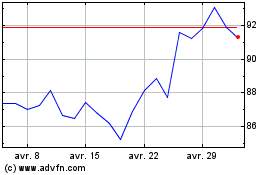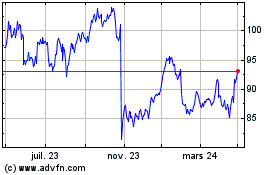Sanofi announces positive long-term efficacy and safety data for fitusiran from interim analysis of Phase 2 extension study i...
19 Juin 2020 - 3:00PM

Sanofi announces positive long-term efficacy and safety data for
fitusiran from interim analysis of Phase 2 extension study in
people with hemophilia A and B, with or without inhibitors
Sanofi announces positive long-term efficacy and safety data
for fitusiran from interim analysis of Phase 2 extension study in
people with hemophilia A and B, with or without inhibitors
- Fitusiran, a novel RNAi therapy in development, has the
potential to transform the treatment of hemophilia with a monthly,
subcutaneous treatment for people with hemophilia A and B, with or
without inhibitors
- Long-term exploratory data show prophylactic treatment with
fitusiran provides a sustained reduction in annual bleed rates in
moderate to severe hemophilia A and B patients, with or without
inhibitors.
Paris – June 19, 2020 – New data
exploring the efficacy and safety of fitusiran, an investigational
once-monthly, subcutaneously administered RNA interference (RNAi)
therapy for the treatment of hemophilia A and B, with or without
inhibitors, were shared today in a late-breaking presentation at
the World Federation of Hemophilia Virtual Summit.
Long-term interim results from the Phase 2
open-label extension (OLE) study reinforce fitusiran’s potential to
restore hemostatic balance and to lower annualized bleed rates
(ABRs) over a period up to 57 months.
“These new interim data support the potential of
fitusiran to have a transformative impact on hemophilia management
with the aim to provide patients with consistent bleed protection
and only once monthly subcutaneous dosing,” said Dietmar Berger,
Global Head of Development, Sanofi. “We are continuing to advance
our portfolio of factor and non-factor therapies that could offer
people with hemophilia a broad range of therapeutic options to fit
their individual needs. We continue to investigate the clinical
profile of fitusiran in our Phase 3 ATLAS program with results
expected in the first half of 2021 and look forward to offering
this novel therapy to patients globally.”
The Phase 2 open-label extension studyThe
Phase 2 OLE study evaluates the long-term efficacy and safety of
fitusiran in patients with moderate or severe hemophilia A and B,
with or without inhibitors, who had participated in a previous
study of fitusiran. This data evaluated 34 enrolled patients who
received monthly fixed 50 mg or 80 mg doses of fitusiran and were
followed for a period up to 4.7 years, with a median exposure of
2.6 years. At the data cutoff (March 10, 2020), interim results
showed:
- Monthly subcutaneous dosing with fitusiran, in patients with
hemophilia A and B, with or without inhibitors, demonstrated
sustained antithrombin lowering (a reduction of around 75% from
baseline), resulting in median peak thrombin values at the lower
end of the range observed in healthy volunteer participants.
- Low overall median ABR of 0.84. The median ABR in the
non-inhibitor subgroup was 1.01 compared to pre-study median ABRs
of 2.0 for patients previously on prophylactic
treatment and 12.0 for patients previously on demand. In the
inhibitor subgroup, median ABRs were 0.44 compared to pre-study
median ABRs of 42.0.
- Low overall spontaneous bleeds (overall median of 0.38).
Median spontaneous ABRs by subgroup were 0.33 (non-inhibitor) and
0.39 (inhibitors).
- No anti-drug antibody formation was detected
As of the data cut on March 10, 2020, fitusiran
was generally well tolerated. Reported serious adverse events with
fitusiran included an event of atrial thrombosis and an event of
increased liver transaminases. One death occurred in the study in
2017; this was due to cerebral venous sinus thrombosis initially
diagnosed as subarachnoid hemorrhage after which the bleed
management guidelines were updated in December 2017. The most
commonly reported adverse events (≥5 patients) included an increase
in alanine aminotransferase (29%), headache (27%), injection site
erythema (21%), nasopharyngitis (21%), upper respiratory tract
infection (18%), diarrhea (18%), arthralgia (18%), back pain (18%),
and an increase in transaminases (15%).
A novel investigational approach for hemophilia A and
B
Hemophilia A and B are characterized by
hemostatic imbalance due to factor VIII and IX deficiency,
respectively, resulting in insufficient thrombin generation. All
therapies for hemophilia aim to restore hemostatic balance and
improve thrombin generation.
Fitusiran is an investigational, once-monthly,
subcutaneously administered RNA interference therapeutic in
development for the treatment of people with hemophilia A and B,
with or without inhibitors. Fitusiran is designed to target
antithrombin, a protein that inhibits blood clotting, with the goal
of promoting sufficient thrombin generation to naturally rebalance
hemostasis and prevent bleeds. Fitusiran utilizes Alnylam's
ESC-GalNAc conjugate technology, which enables subcutaneous dosing
with increased potency and durability. Fitusiran is currently under
clinical investigation and has not been evaluated by any regulatory
authority.
|
About Sanofi Sanofi is dedicated to supporting
people through their health challenges. We are a global
biopharmaceutical company focused on human health. We prevent
illness with vaccines, provide innovative treatments to fight pain
and ease suffering. We stand by the few who suffer from rare
diseases and the millions with long-term chronic conditions.
With more than 100,000 people in 100 countries, Sanofi is
transforming scientific innovation into healthcare solutions around
the globe. Sanofi, Empowering Life |
|
Sanofi Media Relations Contact Sally BainTel.: +1 (781) 264
1097Sally.Bain@sanofi.com |
Sanofi Investor
Relations Contact Felix Lauscher Tel.: +33 (0)1 53 77 45 45
ir@sanofi.com |
|
Sanofi Forward-Looking StatementsThis press release contains
forward-looking statements as defined in the Private Securities
Litigation Reform Act of 1995, as amended. Forward-looking
statements are statements that are not historical facts. These
statements include projections and estimates and their underlying
assumptions, statements regarding plans, objectives, intentions and
expectations with respect to future financial results, events,
operations, services, product development and potential, and
statements regarding future performance. Forward-looking statements
are generally identified by the words “expects”, “anticipates”,
“believes”, “intends”, “estimates”, “plans” and similar
expressions. Although Sanofi’s management believes that the
expectations reflected in such forward-looking statements are
reasonable, investors are cautioned that forward-looking
information and statements are subject to various risks and
uncertainties, many of which are difficult to predict and generally
beyond the control of Sanofi, that could cause actual results and
developments to differ materially from those expressed in, or
implied or projected by, the forward-looking information and
statements. These risks and uncertainties include among other
things, the uncertainties inherent in research and development,
future clinical data and analysis, including post marketing,
decisions by regulatory authorities, such as the FDA or the EMA,
regarding whether and when to approve any drug, device or
biological application that may be filed for any such product
candidates as well as their decisions regarding labelling and other
matters that could affect the availability or commercial potential
of such product candidates, the fact that product candidates if
approved may not be commercially successful, the future approval
and commercial success of therapeutic alternatives, Sanofi’s
ability to benefit from external growth opportunities, to complete
related transactions and/or obtain regulatory clearances, risks
associated with intellectual property and any related pending or
future litigation and the ultimate outcome of such
litigation, trends in exchange rates and prevailing interest
rates, volatile economic and market conditions, cost
containment initiatives and subsequent changes thereto, and
the impact that COVID-19 will have on us, our customers, suppliers,
vendors, and other business partners, and the financial condition
of any one of them, as well as on our employees and on the global
economy as a whole. Any material effect of COVID-19 on any of
the foregoing could also adversely impact us. This situation is
changing rapidly and additional impacts may arise of which we are
not currently aware and may exacerbate other previously identified
risks. The risks and uncertainties also include the uncertainties
discussed or identified in the public filings with the SEC and the
AMF made by Sanofi, including those listed under “Risk Factors” and
“Cautionary Statement Regarding Forward-Looking Statements” in
Sanofi’s annual report on Form 20-F for the year ended December 31,
2019. Other than as required by applicable law, Sanofi does not
undertake any obligation to update or revise any forward-looking
information or statements. |
- FINAL REVISED - Fitusiran PH2 OE late breaker - 6.18.20 db jn
bs revision
Sanofi (EU:SAN)
Graphique Historique de l'Action
De Mar 2024 à Avr 2024

Sanofi (EU:SAN)
Graphique Historique de l'Action
De Avr 2023 à Avr 2024
